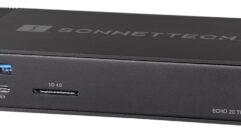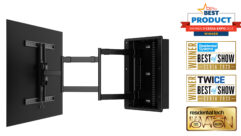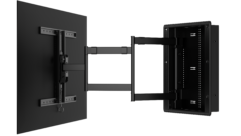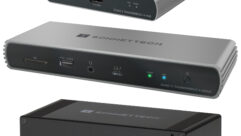
Technology Showcase:
Equipment Racks
Jul 1, 2006 12:00 PM,
By Jay Ankeney
Today’s racks do more than just protect AV equipment.
In some ways, 19in. equipment racks in permanent AV installations can be compared to ballroom dancing. Just as the three-quarter beat of a waltz is understood the world over, the physical parameters of a 19in. AV rack are set by international standards. But choosing the various components, including determining the rack’s structural design, content, and covering, is left up to each individual manufacturer.
Winsted System/85
It was industrialist George Westinghouse who first chose the 19in. shelving width back in the 1890s to hold the early electronic switching gear used in his railroad empire. Early telephone companies later adopted the width. Today, that legacy lives on as 19in. racks are still occasionally referred to as “relay racks” or “stacks.” The rack-ready equipment they hold is often 17in. wide with 1in. mounting handles on each side; although, with the shrinking size of electronic equipment these days, the size of various components can vary greatly.
MODERN RACKS
Modern rackmounting systems for sophisticated electronics have evolved far beyond mere enclosures designed to generally protect equipment. They now frequently serve as ancillary systems integral to the proper maintenance, preservation, and functioning of valuable components, and the variety of designs available to AV installers has become as diverse as the equipment the racks hold.
There are three major international standards for 19in. equipment racks: 310-D from the EIA (Electronic Industries Alliance); 60297, set by the IEC (International Electrotechnical Commission); and the German Institute for Standardization or DIN (Deutsches Institut für Normung e.V.) standard, 41494 SC48D. Although there are many other specifications dealing with individual components and applications, these three overarching standards provide professional installers a uniformity of size, and facility owners a certainty of safety.
To hold equipment, the front of each rack has two parallel, vertical metal mounting rails. The strips are each 0.625in. wide and are separated by a gap of 17.75in., creating an overall rack width of 19in. Regularly spaced holes in these mounting rails make aligned pairs separated by 18.3in horizontal. The holes in the strips are arranged vertically in repeating sets of three, with their centers separated by 0.5in., 0.625in., and 0.625in. Therefore, this pattern repeats every 1.75in., forming a containment area that is called a rack unit (RU).
As a result, the vertical dimension of 19in. racks is often measured in the number of RU space compartments they can hold. Equipment designed to fit these racks is conventionally described by the number of RUs it occupies. A typical oscilloscope takes up 4RU, while a rackmountable computer is usually only 1RU or 2RU.
Originally, the mounting holes were tapped to receive a particular type of threaded bolt. But more recently, racks with plain square holes are becoming common, since square-holed racks allow boltless mounting with the use of cage nuts. A cage nut consists of a spring steel cage containing a captive nut, and it’s designed to clip permanently into a square mounting hole. Some manufacturers have also conjured up their own proprietary mounting schemes for ease of installation.
Rackmountable equipment is usually bolted onto the vertical strips, unless this would not furnish enough structural support for its weight. For heavier equipment, a second pair of mounting strips is located at the rear of the rack, so the gear can be attached on all four corners. Heavy equipment is supported by horizontal rails that allow it to be slid out for maintenance. In some cases, these rails can also be used to hold enclosed shelves. The front and back rails are typically spaced 31.5in. apart, although this can vary depending upon the type of equipment to be mounted.
The 19in. racks can either be self-standing or ganged together to become integrated enclosure systems, with unifying front panels providing security, as well as minimizing the racks’ industrial appearance. For corporate boardroom installations, 19in. racks are often built right into the woodwork, with adorning facades that let them match the room’s decor.
In addition to the number of RUs, considerations for selecting the proper 19in. rack mount include ventilation (fans, blowers, and thermostat controls); open designs versus doors, which can accommodate locks; cable management to suit the kind of equipment being installed; AC power strips and sequencers; and the ease of access to the rear of the equipment for installation, maintenance, and wiring.
Stringent seismic security regulations for permanently installed 19in. racks, whether floor-standing or wall-mounted, can affect the price of the rack and the cost of its installation. There are five important codes that enclosures and consoles should be certified to meet, including the Uniform Building Code (UBC) 1997, the International Building Code (IBC) standard of 2000 and 2003, the California Building Code (CBC) 1998, the American Society of Civil Engineers (ASCE) 2002, and National Fire Protection Agency (NFPA) 2003 ratings. Often, floor-standing racks will be mounted on pedestals or raised floors over a riser base system, and these should also be seismically certified.

Lowell LPT 4-19
THE OFFERINGS
With all these regulations, codes, and required certifications, choosing a 19in. rack-mounting system involves more than meets the eye. Fortunately, several companies have come up with innovative designs to help AV installers. All of them make various models, but the following are some of their most popular 19in. rack offerings.
The economical WA100 series of vertical racks from Phoenix-based Atlas Sound come completely welded and ready for equipment installation. All five models are constructed of 16-gauge CRS (cold-rolled steel), and include base, top panel, side panels, mounting rails, and a removable rear door with cylinder lock and flush door pull. The racks’ rear doors are hung with quick-release spring hinges, which allow them to be rotated 180 degrees for right- or left-hand opening.
Atlas Sound’s flagship line of vertical 19in. racks is its FMA series, the company’s least expensive gangable racks. These racks include Gripsert hardware that allows the installer to attach the door without the typical nut-and-bolt hardware, so a door can be mounted on a cabinet already filled with gear. The 44RU FMA 503-77B-962 offers Atlas Sound’s IsoPanel covering, a non-conductive polymer panel designed to isolate the rack from the building’s electrical system. The rack’s unique side panels are hinged to swing out for convenient service access.
Missouri-based Home, Inc. was the first company to manufacture cabinets specifically for the audio market back in the early 1950s. Today, the company’s most popular 19in. floor-standing racks for AV installations come from its DRV (five) series, which Home calls Dupli-Rack Multi-Bay cabinets. These rack systems are offered in two depths (DRV-2, 25.5in. and DRV-3, 30.75in.) and six heights ranging from 21RU to 48RU. The frame assembly is a 14-gauge CRS-welded, open-sided frame for multi-bay configurations, and has an open top panel to allow for mounted accessories. Each DRV cabinet is equipped with two pairs of 11-gauge CRS equipment mounting rails, punched and tapped for 10-32 threads on standard EIA universal spacing. The finish can be iron-phosphate cleaned, standard finish textured black, or one of Home, Inc.’s many baked enamel colors.
Just starting to ship in April of this year, Lowell Manufacturing’s (Pacific, Mo.) new LPT 4-19 series Pull and Turn slide-out mounting system for built-in wall and millwork applications features four heavy-duty slides for smooth pullout access to rackmounted equipment. The LPT series features a push-button lock and release that allows the rack to rotate up to 90 degrees on a turntable when fully forward. For installation convenience, the rack may be removed from the turntable, allowing equipment to be mounted at the shop and wired while the field team installs the turntable base into the wall or cabinetry. The LPT series is available in space heights of 17.5in. (10RU), 21in. (12RU), 28in. (16RU), and 36.75in. (21RU).
Also available from Lowell are its L277 (19″×27″), L278 (19″×32″), and L279 (19″×36″) open-floor ganging rack systems. Each of these has 19in. rackmount spacing built into the top structure of the cabinet to permit the installation of additional accessories, such as cooling fans.
Laser fabrication cells, which produce smooth edges friendly to both cables and contractors’ hands, epitomize Middle Atlantic’s (Fairfield, N.J.) 19in. rack manufacturing prowess. The company’s WR and AXS systems (the former available in 37RU and 44RU sizes) consist of a rotating rack frame inside a host enclosure, letting the user gain unrestricted access to equipment and cabling without the need for tracks and stands. New rear-access panels on the company’s AXS system are available for rear security or for active thermal management.
Middle Atlantic’s SR-series pivoting rack can rotate on its floor base for easy equipment access. Its front-mounted Zero Clearance Latch saves valuable wall space by allowing wall racks to be placed side-by-side, in a corner, or wherever space is an issue. And the RK/BRK series of laminated racks lets shelves and rackmount components coexist in the same enclosure with a unique pin-based shelving system.
The Open Bay line of racks from Miami-based Racks Unlimited includes several sizes ranging from 72in. to 96in. The racks are constructed of 14-gauge, industrial-grade steel. They are made on a robotic welder and come with bottom angle corner gussets for rigidity and strength and optional heavy-duty casters. The company’s Quarter Rack 19in. mount enclosure (22RU high) is designed to enhance the image and security of a network environment. Painted with an industrial polyurethane high solid paint, the racks comply with OSHA’s V.O.C. (Volatile Organic Compounds) regulations. Their front and rear doors are 16-gauge steel, and the side panels are 18-gauge steel, both welded and ground smooth for a superior finish.

Middle Atlantic WR443
As the pioneers of the concept of rotating racks, the ROTR rotary rack system from Raxxess Metalsmiths (Paterson, N.J.) comes in sizes ranging from 8RU to 24RU. ROTR extends 20in. from its frame and then swivels up to 90 degrees in either direction for unobstructed access to components, regardless of their depth. The ROTR-XL version has an extended base design to increase clearance when mounted behind cabinet doors. For use with more heavy-duty systems, the Raxxess ROTR-HD rack, designed for installation in cabinetry and custom millwork, is available in sizes up to 44RU and features a weight capacity of 650lbs. properly distributed.
For a more furniture-like appearance, the Raxxess Boardroom Group (BRG) is a cabinet-design rack with a vinyl java-colored finish wrapped over medium-density fiber board. The BRG comes in a Lowboy two- or three-bay configuration with Plexiglas doors, or as a Highboy with three vinyl shelves or 24RU of rack rail for front mounting.
As a relative newcomer to the 19in. rackmount community, Unitec Products’ message is fairly simple. It provides bread-and-butter permanent-installation racks that compete strongly on their cost-effectiveness, since they are either manufactured to a client’s specifications or imported from factories in China. The Ohio company’s Broadcast Series professional metal equipment racks range from 8RU to 24RU. They all ship flat and feature organic glass doors, vented design, and tapped steel front and back rack rails. For easy access, the racks feature open access side panels that pop off with click levers. Small computer-style fans at the top and bottom of the rack allow air to flow through the entire enclosure to keep equipment cool. Unitec systems come with casters for mobility, but also shock-mounted rubber feet for stability.
Several decades ago, Minnesota-based Winsted was the first manufacturer to offer 19in. rackmount systems with modular consoles to allow for reconfiguration as equipment needs changed. Today, Winsted offers five separate lines of vertical racks, in both fully welded and easy-to-assemble knocked-down versions.
For the past 30 years, the System/85 has been Winsted’s standard line, offering interchangeable components consisting of welded frames and vented side panels, tops, and pedestals. The System/85 racks are designed to work with System/85 consoles. Winsted’s Pro Series I line ships in flat knock-down packs available in 35in. (20RU), 70in. (40RU), and 78.75in. (45RU) heights. Each rack comes complete with vented sides, a solid top, an open base for cabling, numbered and punched adjustable front and rear rack rails and leg levelers. Its completely welded Pro Series II vertical racks are Winsted’s most economical fully welded vertical rack systems. These are available in nine sizes, with heavy-duty welded frames, fully adjustable racks, and both front- and rear-tapped rack rails.
For More Information
Atlas Sound
www.atlassound.com
Home, Inc
www.home-inc.net
Lowell Manufacturing
www.lowellmfg.com
Middle Atlantic
www.middleatlantic.com
Racks Unlimited
www.racksunlimited.com
Raxxess
www.raxxess.com
Unitec Products
www.unitecproducts.com
Winsted
www.winsted.com










